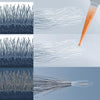
Chemical treatments – Influence on hair structure
3 min reading time

3 min reading time
Learn what chemical treatments do to hair structure. Discover how bonds can be broken, reformed, and repaired for safe, long-lasting results.
The influence of chemical treatments on hair structure
Coloring, straightening, perms, keratin, Nanoplastia—chemical treatments are the backbone of the modern salon. They transform hair, but simultaneously alter its molecular structure . For a professional, it's essential to understand exactly what happens within the hair fiber , so that each treatment delivers results without permanent damage.
1. What happens chemically in the hair?
The hair is made up of keratin chains connected by three types of bonds:
✔ Hydrogen bonds – determine shape and elasticity; are broken by water or heat.
✔ Salt bridges – affected by pH changes (acidic or basic).
✔ Disulfide bonds – the strongest connections; responsible for the natural shape (straight or curly).
Chemical treatments work by temporarily breaking and reforming these bonds – a controlled manipulation of the hair structure.
2. Hair coloring – pigment and oxidation
During coloring, ammonia or ethanolamine opens the cuticle, allowing color pigments (oxidation dyes) to penetrate the cortex.
✔ Hydrogen peroxide oxidizes the natural pigment (melanin).
✔ New color pigments are formed in the fiber.
✔ Then an acidic conditioner closes the cuticle again.
Repeated bleaching or excessively high peroxide concentrations cause porosity and protein loss .
3. Uncurling and perm
These processes break and reform disulfide bonds using reducing agents such as thioglycolic acid or cysteamine .
✔ Straightening – breaks bridges and straightens hair.
✔ Permanent – breaks bridges and forms new ones with curl tension.
✔ Neutralization – restores connections through oxidation.
Incorrect timing or too high pH (>9) leads to irreparable damage to the cortex.
4. Keratin and amino acid treatments
Treatments such as Nanoplastia, Bioplastia or Hair Botox work mildly, but on a similar principle.
✔ They fill broken structures with amino acids, keratin and lipids .
✔ Heat (230°C) closes the new connections.
✔ The structure is rebuilt, not just temporarily coated.
Unlike chemical relaxers, these systems are formaldehyde-free and biocompatible with the hair structure.
5. The role of pH and neutralization
Every chemical reaction in the hair changes the pH.
✔ Alkaline environment (pH >8) → opens the cuticle.
✔ Acidic environment (pH <6) → seals and stabilizes.
A professional treatment always ends with a pH restoration . Without this, hair remains porous, loses moisture, and breaks more easily.
6. How do you recognize overloaded hair due to chemicals?
Professionals pay attention to signals:
✔ Hair feels “rubbery” when wet.
✔ Loses shine and resilience.
✔ Breaks even under light tension.
✔ Pigment takes unevenly.
This means that the disulfide bridges are damaged and immediate reconstruction is required.
7. Professional aftercare and recovery
✔ Use a Plex or Bond Rebuilder immediately after treatment.
✔ Avoid washing within 48 hours – bonds need to stabilize.
✔ Restore weekly with masks rich in keratin, collagen or amino acids .
✔ Avoid sulphates and high temperatures.
✔ Always work with low pH products .
Professional restoration prevents chemical forces from turning into structural damage.
Conclusion: Chemistry is power – if you understand hair physics
Chemical treatments aren't the enemy, but tools for transformation. Only knowledge of molecular processes ensures that results and health go hand in hand. A professional who understands how to break and repair bonds controls beauty at a scientific level.